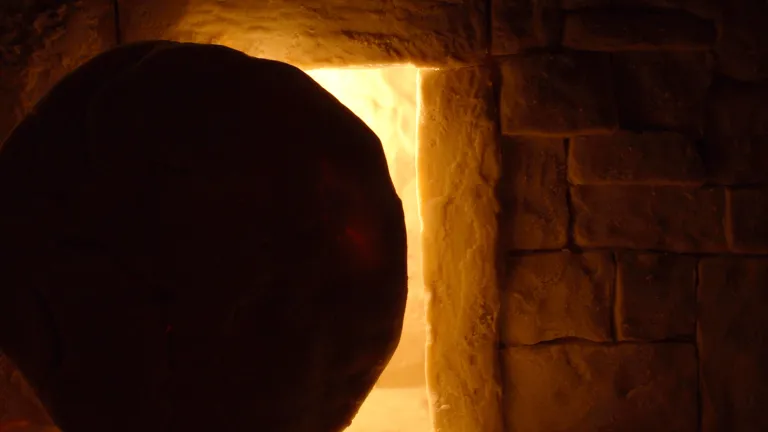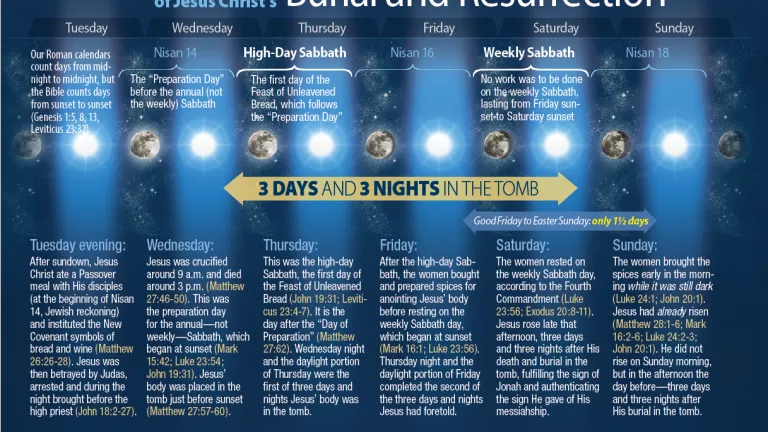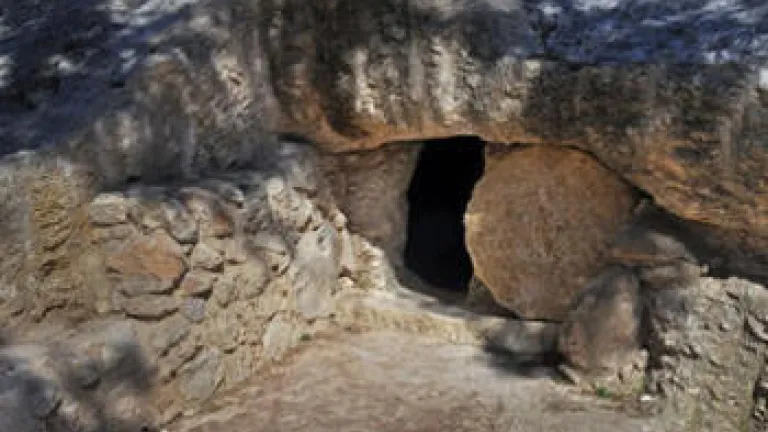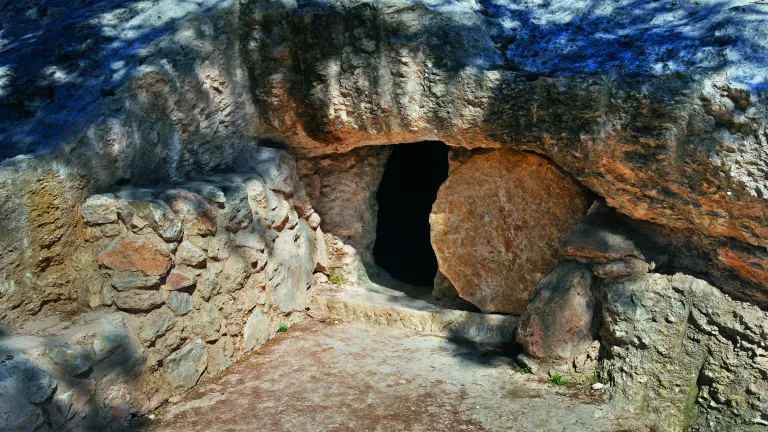Three Days and Three Nights

The choice of a Sunday date for Easter is based on the assumption that Christ rose from the grave early on a Sunday morning. The popular belief is that Christ was crucified on a Friday and rose on a Sunday. But neither of these suppositions is true. A close reading of the Bible makes that quite clear.
Matthew 12:38 shows some of the scribes and Pharisees asking Jesus for a sign to prove He was the Messiah. Jesus told them that the only sign He would give was that of the prophet Jonah: "For as Jonah was three days and three nights in the belly of the great fish, so will the Son of Man be three days and three nights in the heart of the earth" (Matthew 12:40).
But can we fit "three days and three nights in the heart of the earth" between a Friday-afternoon crucifixion and a Sunday-morning resurrection? The traditional view of the crucifixion and resurrection only allows for Jesus to have been entombed for a day and a half.
Some try to reconcile Christ's words with their belief in a Friday crucifixion and Sunday resurrection by rationalizing that Christ's "three days and three nights" statement does not require a literal span of 72 hours. They reason that a part of a day can be reckoned as a whole day. Hence, since Jesus died in the afternoon—around "the ninth hour" after daybreak, or about 3 p.m. (Matthew 27:46-50)—they think the remainder of Friday constituted the first day, Saturday the second and part of Sunday the third.
However, they fail to take into consideration that only two nights—Friday night and Saturday night—are accounted for in this explanation. After all, the Bible is clear that Jesus had already risen before the daylight portion of Sunday (John 20:1). Something is obviously incorrect in this common conclusion regarding when Christ was in the tomb.
Jonah 1:17, to which Christ referred, states specifically that "Jonah was in the belly of the fish three days and three nights." We have no reason to think these days and nights were fractional. Nor is there any basis for thinking that Jesus meant only two nights and one day, plus parts of two days, when He foretold the length of time He would be in the grave. Such rationalization undermines the integrity of Jesus' words.
The reason that Friday is the day most think of as the day of Christ's crucifixion is that Mark 15:42 states that it was the preparation day (the day before the Sabbath). In the normal weekly Sabbath cycle, Friday is indeed the preparation day. But in this case, there were two Sabbaths during that week. The Sabbath referred to in Mark 15:42 was an annual Holy Day—the First Day of Unleavened Bread. John 19:31 confirms this by specifically stating that it was a high day, or annual Holy Day. Then two days later was the weekly Sabbath, which is the one referred to in Luke 23:56.
When did Jesus die and when was He resurrected?
Here's the timeline: Jesus was laid in the tomb in a hurry, as sunset (the beginning of the Holy Day) was approaching (Mark 15:42). Joseph of Arimathea, wanting to properly bury Jesus before the beginning of the high Holy Day, took down Jesus' body and wrapped it in linen. He then placed the body in the tomb (Luke 23:53; Mark 15:43). Luke's account then says Jesus' female disciples observed that He was buried as the Sabbath drew near (Luke 23:54-55).
After seeing Christ's body being laid in the tomb just before sunset, the women then "returned and prepared spices and fragrant oils [for the final preparation of the body]. And they rested on the Sabbath according to the commandment" (Luke 23:56). How could they have prepared these spices and oils in the very short time before sunset?
The wording of Mark 16:1-2 adds to the confusion some experience because it seems to suggest that the spices were purchased after the weekly Sabbath rather than before it on Friday? How is that possible?
By comparing details in both Gospels—where Mark tells us the women bought spices after the Sabbath and Luke relates that they prepared the spices before resting on the Sabbath—we can see that two different Sabbaths are mentioned. The first, as John 19:31 tells us, was the first day of the Feast of Unleavened Bread. The second was the weekly seventh-day Sabbath. Mark did not mention this weekly Sabbath rest in his account, but Luke, who wrote his account of these events later, did.
Thus, the women returned after seeing the burial Wednesday afternoon. They rested on the high-day Sabbath Wednesday night and Thursday. They bought the spices either Thursday night or Friday morning. They prepared them on Friday prior to sunset and then rested on the weekly Sabbath from Friday sunset to Saturday sunset.
Then, early on Sunday, before dawn, "while it was still dark" (John 20:1), they went to the tomb to apply the embalming mixture. They discovered that Christ had already been resurrected (Matthew 28:1-6; Mark 16:2-6; Luke 24:1-3). The only plausible timeline for the events of the crucifixion week is that Christ was in the grave three full days and three full nights, from late on a Wednesday until late on a Saturday.
Now, consider Christ's promise that He would be in the grave for the same length of time that Jonah was in the belly of the great fish in conjunction with this historical record. What is the correct way to understand "three days and three nights" in both Matthew 12:40 and Jonah 1:17? It means three literal days and three literal nights—72 full hours.
Sign of the Messiah
If Jesus were in the tomb only from late Friday afternoon to sometime early Sunday morning, then the sign He gave that He was the prophesied Messiah was not fulfilled. The claim of His Messiahship rests on the fulfillment of His words—it's that serious a matter.
When we allow the Scriptures to interpret themselves, all four Gospel accounts accurately harmonize and attest to the validity of Jesus' promise that He would be in the grave three days and three nights—not just part of that time.
Several Bible translations recognize that more than one Sabbath is discussed in these events. In Matthew 28:1 some Bible versions, including Alfred Marshall's Parallel New Testament in Greek and English, Ferrar Fenton's Translation and Green's Literal Translation, properly translate a phrase occurring here as "after the sabbaths." Young's Literal Translation and The Complete Word Study Dictionary: New Testament (1992, p. 1270) similarly acknowledge that multiple Sabbaths are intended here.
Some stumble over Mark 16:9, not taking into account that there is no punctuation indicated in the original Greek. Therefore, to be in harmony with the material presented in the other Gospels, a better translation of the verse would be: "Now having risen, early the first day of the week He appeared first to Mary Magdalene..." So it's not saying that Jesus rose early on Sunday morning, but that He appeared early on Sunday morning to Mary Magdalene, having already risen some time earlier.
We can be assured that the duration of Christ's entombment before His resurrection, which He foretold as proof of His Messiahship, was precisely as long as He said it would be—equaling the "three days and three nights [Jonah was] in the belly of the great fish" (Matthew 12:40). Thus, Jesus rose late Saturday afternoon around sunset—not Sunday at sunrise—exactly three days and three nights after He was placed in the tomb just before sunset on Wednesday.
Christ's prophecy of the time He would be in the tomb was fulfilled precisely. Because most people do not understand the biblical high days kept by Jesus Christ and His followers, they fail to understand the chronological details so accurately preserved for us in the Gospels.







